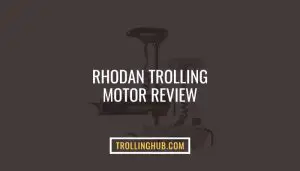Trolling is a productive fishing method for catching salmon of all sizes from small pink salmon to large chinook or king salmon. Considering some essential factors, you can make effective trolling.
It is frequently carried out in sea or freshwater regions where salmon are known to move and can be done from a variety of boats, including kayaks, canoes, and bigger fishing vessels.
Knowing the right techniques and preparation with some specialized gear including fishing rod, reel, baits or lures etc. salmon trolling can be exciting for people of all ages.
Let’s go through the article for detailed techniques, best time, bait and rig for salmon fishing.
Trolling For Salmon: Effective Techniques
Trolling for salmon can be an effective technique for catching these fish, especially in areas with a strong current or a lot of underwater structure. Some effective techniques while trolling for salmon include:
- Different speeds and angles can help to create a more natural-looking movement of the lure or bait, which can be more attractive to salmon.
- At different seasons of the year and in various water conditions, particular lures and baits may be more effective. It’s a good idea to keep a variety of lures and bait on hand and to test with them to determine which ones work the best.
- Depending on the season and the water’s conditions, salmon can be found at various depths.
- In some climates and water temperatures, salmon may be more active. The chances of catching fish can be increased by paying attention to these aspects.
- Some lures and baits are designed to generate a scent or taste that salmon find attractive. Using these types of attractants can help to boost the odds of catching salmon.
Trolling For Salmon With Downriggers
Trolling for salmon with downriggers is a popular and effective technique that involves using a boat to pull baits or lures through the water at a specific depth.
Downriggers are specialized fishing equipment that consists of a weighted line that is attached to the boat and lowered into the water, with a release clip at the end to hold the fishing line.
To troll for salmon with downriggers, you will need a boat with a trolling motor or outboard motor, as well as the downrigger equipment.
Begin by setting the downrigger to the desired depth, which will depend on the location, time of year, and type of salmon you are targeting. You can use a fish finder or other depth-finding device to determine the depth of the salmon.
Next, attach your bait or lure to the end of the fishing line, and clip it onto the release clip on the downrigger. As you troll the boat through the water, the downrigger will hold the line at the desired depth, allowing you to present the bait or lure to the salmon in the most effective way.
When fishing with downriggers, it’s important to pay attention to the depth, speed, and direction of the trolling, as these can all affect the success of the rig.
Trolling For Salmon Without Downriggers
Trolling salmon with downriggers makes your life easier there’ve numerous successful trolling for salmon without downriggers. This can be done by attaching the lure or bait to a long line and letting it trail behind the boat, or by using a rod and reel to cast the line out behind the boat.
One way is to use a method called “flatlining”, which involves attaching a weight to the line and allowing it to sink to the desired depth. The weight will help to keep the line in place and prevent it from tangling.
Another way is by attaching a buoyant device called a “dipsy diver” to the line. This device can be set to a specific depth and is used to pull the line deeper and deeper into the water.
Overall, trolling for salmon without downriggers can be an effective way to catch these fish, but it requires some trial and error to find the right combination of speed, depth, and lure or bait to attract the fish.
Best Time To Troll For Salmon
All anglers should be aware that the quantity and quality of salmon they catch depend on the time of day and season. So the peak moments of salmon trolling guarantee you the best salmon catch.
Best time of the day
Early morning just before sunrise, and late evening just after sunset are the best times in a day for trolling salmon. And all through the night is the perfect time. Generally the worst time to troll for salmon is around noon, during the heat of the day.
Morning
Early dawn is preferable for getting a good number of salmon. They are still highly busy from the previous night at this time (considering the water was undisturbed).
Noon
Salmon tend to move into deeper water whenever the water temperature rises from midday to the afternoon, much like any other fish. Because of this, if you want to catch more fish, you should avoid fishing at noon.
Night
From early evening to all through the night is ideal for salmon fishing and this is our recommended time for salmon trolling. The water temperature is perfect and suitable for the salmon to settle down in.
Times Depends on Moon
The moon has a definite impact on all types of night fishing. The moon regulates tides in addition to lighting up submerged lures. Moon phases, high and low tides, and even the approach of low-pressure systems can improve your chances to catch more salmon.
The best moon phases for salmon are often the 3 or 4 days around the new moon and 3 or 4 days around the full moon.
Best Times of the Year
Now you already know the best timing to go for salmon trolling, but you should be aware what month will give you the best outcome. Of course, you have the option of going whenever you want, but knowing when to go helps guarantee a successful catch.
Spring
The water temperature starts to rise as the winter ice melts. The bottom source, which rises, takes the place of the melting ice. Salmon choose shallow locations because the water there warms up more quickly.
Summer
The best time for fishing salmon during the summers. The salmon move to warmer waters to find a more stable oxygen level due to the heated layer of water created by the heat. The thermocline, or the boundary between warm and cold water, should be sought after.
Pick salmon trolling season in the last frontier starts in May and goes all the way through to the end of September.
Autumn
Autumn is the another best time of year to catch salmon since the surface water fluctuates with the four seasons and the temperature. Salmon from the coast migrate inland, making them accessible.
Winter
Salmon might be suitable for ice fishing. In regions with high temperatures, they frequently stick to the ice. However it could be difficult to troll for salmon in the winter season.
Trolling For Salmon Setup
Trolling for salmon can be a rewarding and exciting experiment if you have the right equipment and setup to increase your chance of success. Here are some tips for setting up your gear for salmon fishing.
- Rod and reel: Choose a rod with fast and medium-fast action, which will allow you to feel the fish and set the hook quickly. Look for a reel with a smooth drag system as the salmon is a powerful fighter.
- Line: Use a braided or fluorocarbon line with a high breaking strength, as salmon can be quite large and powerful. The line should also be matched to the weight of the rod and reel.
- Leader: A leader is a length of monofilament or fluorocarbon line that is attached to the main line. It is typically shorter and has a lower breaking strength than the main line. Leaders help to protect the main line from abrasions and provide a more natural presentation of the bait or lure.
- Baits or Lures: Salmon can be caught using a variety of baits and lures, including live bait, jigs, spinners, and flies. Choose a bait or lure that is appropriate for the size and species of salmon you are targeting, as well as the type of water you are trolling in.
- Hooks: Select a sharp, durable hook that is appropriate for the size of the salmon you are targeting. For larger salmon, consider using a circle hook, which is designed to hook the fish in the corner of the mouth, reducing the chances of injury.
- Terminal Tackle: This includes items like sinkers, swivels, and split shots, which are used to weigh the bait or lure and help it reach the desired depth.
- Other Equipment: Other items that may be useful for salmon fishing include a landing net, pliers, a fillet knife, and a cooler to store your salmon.
By following these tips and choosing the right equipment, you can complete your setup for a successful salmon trolling.
Best Trolling Lures For Salmon
Salmon are not only aggressive, but they’re also extremely territorial. Salmon are not only aggressive, but they’re also extremely territorial. But to be honest it is not hard to catch the salmon because they’re pretty moronic.
You have two ways to get them to bite. Either your lure can be really attractive or it can agitate enough to get them to bite.
There are so many lures, plugs and jerk baits available in the market because at times salmon may be in deep water and you’ll need different lures to reach different depths.
Though if salmon are dumb, you can’t just throw a stick at them and expect them to bite. The best salmon trolling lures will produce the best results, and I’ve made a list of them all here. Let’s explore our top 5 picks of bait for salmon fishing.
1. Blue Fox Rattlin Pixee

The best salmon lure available is this one. The Rattlin’ Pixee Spoons provide an incredible combination of sight and sound attraction. The holographic finish adds maximum flash to presentation and the Rattlin’ Egg-Sac mimics natural noises. Its razor-sharp treble hooks stay sharp and set easily. Particularly salmon won’t stand a chance against this lure.
2. Bill Lewis Knock-N-Trap

This bait has a different effect on salmon than the last one. This salmon lure mimics their prey rather than provoking them. It also creates the impression of a distressed baitfish with its rattling. Any fish would find it difficult to refuse such a simple meal, much less salmon. This lure is second only to the preceding one in terms of its ability to catch salmon.
3. Rapala Super Shad Rap

There isn’t much to say. Because of how realistic the design is, it would stand out among many other lures on the market. The popular Rapala motion that all Rapala lures have is the second feature.
This enables it to mimic swimming baitfish perfectly. I particularly appreciate that it is made of extremely durable Abachi wood. Overall, it will be difficult to find a better salmon crankbait.
4. Goture Shrimp Lure

These shrimp lures are made of premium high quality Silicone material which make the lures more softer and flexible. The shrimp bait saltwater also features ultra-realistic patterns and 3D eyes.
Shrimp Lure has vivid shrimp shape which give it the look and feel of a live shrimp with a realistic design. It creates lifelike swimming movements in the water that makes it hard to resist.
The shrimp lures are simple to use. Hook it up and use it to lure the best fish you ever could. This bait set can be used for various water situations, you can use them in freshwater, saltwater, fishing reefs, estuaries or rivers.
You should definitely have this lure in your tackle box if you’re going salmon fishing.
5. Sptlimes 77 Fishing Lures Set

This choice is appropriate if you’re on a tight budget. You can get a whooping 80 lures for less than $15. The Bionic bait lures and baits are special for fish’s 3D eyes. Make fish think the lure is a real fish then you catch them easier.
You’ll have topwater lures, crankbaits, jigs, shrimp lures, and more. It goes without saying that you’ll need a variety of fishing lures to be successful on every fishing trip. You can troll in any body of water with the set of fishing lures without breaking the bank.
Best Rigs for Salmon Fishing
There are many different rigs that can be effective for salmon fishing, depending on the type of water, the species of salmon you are targeting, and the type of bait or lure you are using. Here are some popular rigs for salmon fishing:
- Single Egg Rig: This rig is often used with live bait, such as a single salmon egg or a piece of nightcrawler. It consists of a single hook, a sinker, and a swivel. The bait is attached to the hook, and the sinker is used to weigh the bait and help it reach the desired depth.

- Spinner rig: This rig is used with spinners, which are lures that have a spinning blade that creates a flashing, reflective effect. It consists of a spinner, a sinker, and a hook. The spinner is attached to the hook, and the sinker is used to weigh the spinner and help it reach the desired depth and attract salmon.

- The slip-bobber rig: This rig is used for fishing with live bait in deeper water. It consists of a main line with a bobber above the bait and a sinker below it. The sinker is attached to the main line with a slip knot, allowing it to slide up and down the line to adjust the depth.

- The hoochie rig: This rig is used for fishing with hoochie lures, which are brightly colored plastic lures that mimic the appearance and movement of small baitfish. It consists of a main line with a hoochie lure attached to the end and a sinker or lead head jig to help it reach the desired depth.

- Jig rig: This rig is used with jigs, which are weighted lures that are designed to mimic the movement of small fish. It consists of a jig, a sinker, and a hook. The jig is attached to the hook, and the sinker is used to weigh the jig and help it reach the desired depth.

FAQs
The speed of trolling for salmon depends on a number of factors. In general, the speed is typically between 1.7 to 2.9 mph. However, this can vary depending on the specific conditions and the preferences of the angler.
Bright color lures are more effective for attracting salmon, as they are more visible to the fish in water. Besides this, chartreuse, orange, pink, silver, and blue color lures are also liked by salmon.
Braided line is the best for trolling salmon, as it is strong and has a small diameter which increases sensitivity and makes it easier to feel bite. Monofilament line is also a good choice for trolling for salmon, as it has a bit of elasticity, which can help to absorb shock and decrease the risks of the line breaking.
When trolling for salmon, it is common to set one or two lines per angler. This enables each angler to cast a line into the water and search a larger area for fish.
Depending on the exact circumstance and the angler’s preferences, the ideal size hook for salmon trolling may differ. When trolling for large chinook salmon, a hook size of 6 to 8 may be appropriate. For smaller coho salmon, a hook size of 2 to 4 may be more suitable.
A rod between 7 and 9 feet in length is ideal for salmon trolling. When the salmon is hooked, this will provide you adequate length to handle its weight and momentum while making longer casting.
Final Thoughts
In conclusion, trolling for salmon is a popular and effective method of fishing that involves casting a lure or bait behind a moving boat to mimic the natural swimming motion of salmon prey.
It is a productive technique for catching a variety of salmon species, including pink, coho, sockeye, chinook, and chum salmon. Trolling requires specialized gear, including a strong fishing rod and reel, and a selection of lures or baits that are effective in attracting the attention of salmon.
Now you know the technique, so set up your equipment, pick the best lures and go for salmon trolling. Wishing you an exciting and rewarding journey.



